Seasoning Cast Iron Pan: Simple Guide
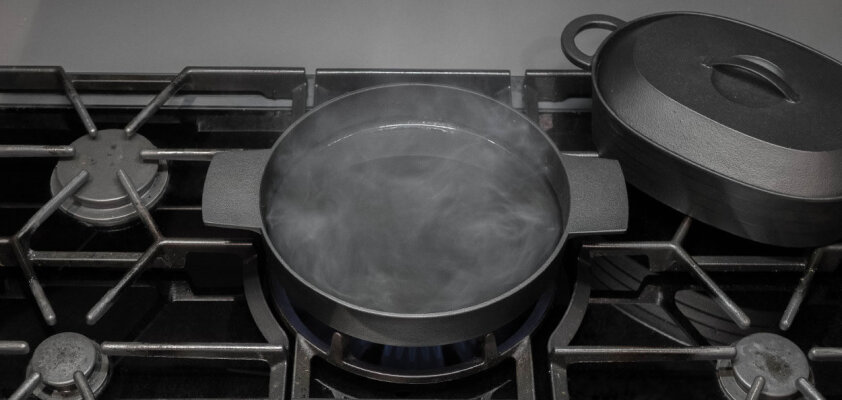
Inhaltsverzeichnis
Video instructions from OIGEN and ORYOKI Video If necessary, remove the corrosion protection from the iron pan Preparing the cast iron pan Heat the cast iron pan The use of salt for baking Alternative procedure for searing the cast iron pan Cleaning after use Summary of the most important aspectsSeasoning a cast iron pan is a simple process, and there are various ways to season a cast iron skillet. This step is crucial to establish the non-stick properties of the pan, ensuring easy cleaning and providing natural rust protection.
Video Tutorial by OIGEN and ORYOKI
In this tutorial, Motoko-San, a Japanese expert, demonstrates step-by-step how to easily season OIGEN cast iron pans with Naked Finish.
This guide is, of course, also suitable for all OIGEN Naked Finish cast iron pans available in the Oryoki online shop. You can recognize them at first glance by their typical gray color before seasoning.
Corrosion protection of the cast iron pan
Iwachu and Kamasada products have a baked-in corrosion protection that should not be removed. Please avoid damaging it. The NakedPan products from Oigen have protection through treatment with very high heat. After seasoning the cast iron cookware, oil and your attention take over the protection against rust.
Removing Dust from Cast Iron Pan
Before the initial use, thoroughly rinse the Sukiyaki cast iron pans from Oryoki with water to remove dust, as they are delivered entirely uncoated and without chemical corrosion protection.
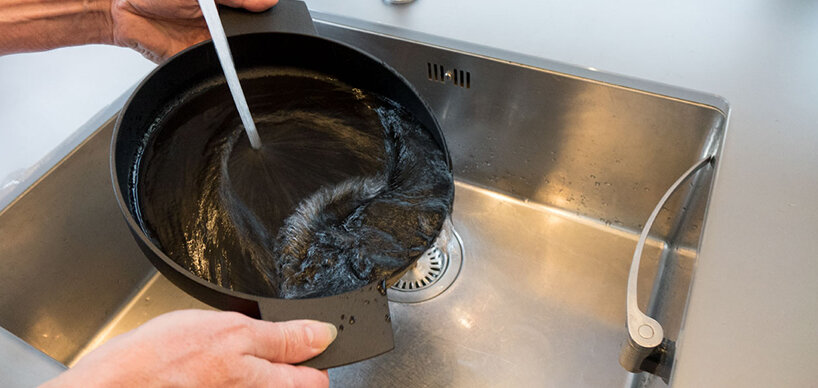
Heat the cast iron pan with vegetable oil
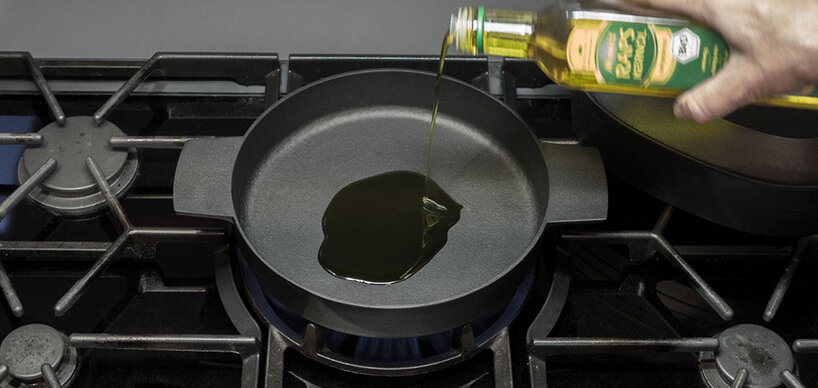


A Tip in Advance: For your cast iron, it's best to use flaxseed oil due to its properties that make it polymerize faster. You can also use another plant oil from your kitchen, such as rapeseed oil; this will simply extend the seasoning process. Heat the cast iron pan on medium heat for a slow warming of the pan's bottom. This will evaporate the water still present in the pores. Alternatively, you can place the pan in the oven and heat it to 100 degrees Celsius (fan-assisted). Remove the cast iron pan as soon as it reaches 100 degrees Celsius. Now, pour a few millimeters of plant oil into the pan. You can evenly distribute the oil with a paper towel and then wipe it carefully. The oil is now in the pores of the cast iron pan. Afterward, you can heat the pan on the highest setting until smoke develops.
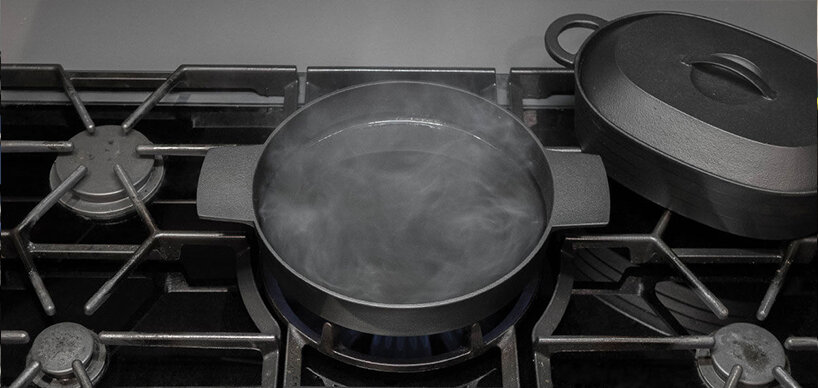
As a result, a dark layer will form, protecting your cast iron pan from sticking and rust. In this step, you can also optionally place the cast iron pan upside down in the oven and set the temperature to 250 degrees Celsius. After reaching 250 degrees, wait for an hour, and then turn off the oven. Allow the pan to cool in the oven for about one to two hours after turning it off, so you don't burn yourself! This method is also ideal for a cast iron pot, including the lid (made of cast iron). By repeating this process, starting with oil in the pan, you enhance the patina that forms, and the non-stick properties of the pan become even better. Opinions on the frequency of repetitions vary. With 3 to 4 repetitions, you should already have a well-seasoned pan. Of course, this doesn't have to be done directly in succession but can be done over a more extended period. You'll recognize a well-seasoned cast iron pan by a slight sheen after these processes.
Immediately after seasoning, you should use a bit more fat for cooking. This will further enhance the patina during use. Classic fried potatoes in oil are an ideal and tasty test for the first use.
Using Salt in Seasoning
For the cast iron pans from Oryoki, we recommend the procedure described above without salt for seasoning the pan. We have tested it ourselves and achieved a very good patina. The use of a handful of salt or potato peels, as described in some other instructions, results in significantly more smoke during seasoning without providing a noticeable advantage.
Different Approaches to Seasoning
In summary, there is no "one true method" for seasoning cast iron. Due to the different manufacturing processes of various pans, one approach may fit better than another. Generally, there is not much that can go wrong. Successful seasoning is indicated by both the color and the non-stick properties of the pan. For the Japanese cast iron pans and cast iron pots from Oryoki, we recommend the procedure described here. Certainly, this method should also work well with high-quality products from other manufacturers.
Cleaning After Use
After cooking, it is sufficient to thoroughly rinse a cast iron pan with warm water, dry it, and rub it with a little oil. Avoid "quenching" with cold water, as the pan could easily warp. If dish soap, cleaning agents, or steel wool are used for cleaning your cast iron grill pan, the seasoning process must be repeated to maintain the ideal patina.
The seasoned pan typically no longer has corrosion protection and should be rubbed with a little oil after cleaning.
Summary: Seasoning a Cast Iron Pan - Step by Step
- If applicable, remove corrosion protection. Rinse cast iron pans without corrosion protection with water.
- Heat the cast iron pan or pot slowly.
- Alternatively, season the pan or cast iron pot with a lid in the oven.
- Best to use flaxseed oil.
- Evenly distribute the oil with a paper towel. It remains in the pores!
- With multiple repetitions of seasoning, the result improves. The cast iron pan turns deep black.
- After seasoning, simply use a bit more fat for cooking.
- After use, rinse with hot water and rub with oil for rust protection (natural corrosion protection).
- Never "quench" cast iron – rapid temperature changes can cause warping!

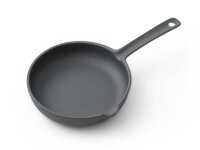
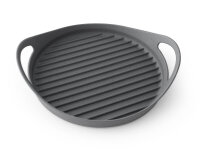
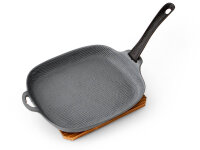
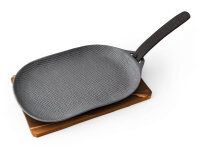
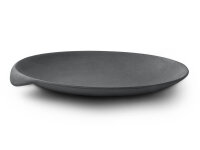
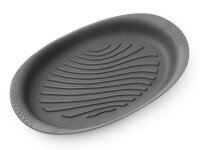
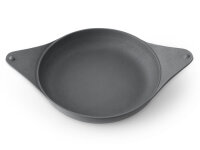
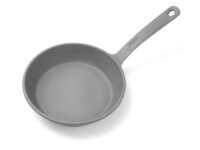
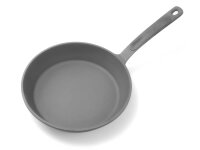
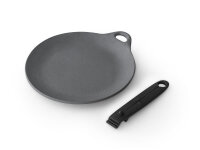
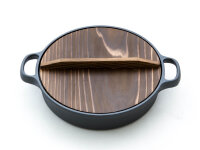
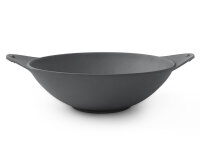










-from-the-yakiyaki-grill-pan.jpg)




